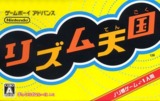Does it keep to the beat, or fail to hit the right chords?
When you first start Rhythm Tengoku you'll be greeted by a testing machine which will ask you to hit the A button in time with the beat tests it throws at you, at the end it gives you a score based on your performance. There is no way to skip it the first time round, so you'll just have to try your best at keeping to the rhythm.
Once that is out of the way you'll gain access to the options and the main game menu. The menu is all in Japanese, so try to be careful not to accidental erase your saved game.
At first you'll have access to just one of the mini-games, unlocking new ones by doing well enough to receive the, mediocre rating. Along the way you'll help a rabbit hop on sea creatures, march to the orders of your commanding officer, clap in time with the music and hit balls into space with a baseball bat while the camera zooms back and forth trying to distract you and generally do plenty of other bizarre things. There plenty of variety in the game's set of rhythmic based challenges and it can be quite addicting.
The occasion game will ask you to use the d-pad in place, or even in combination with the A button, with one game asking to further incorporate the B button to juggle a ball among two people. With certain games this will mean that you'll actually have to pay some attention to the onscreen action as well as listen to the beat, certain games require you to mentally or otherwise count the beat manually as they either remove visual cues or else cut the music completely in order to try and throw you.
Most of the games have intro tutorials which use easy to understand pictures and are simple enough to understand without the need to read Japanese. Once you got you brain around work a game requires the intro can be skipped with a press of the select button. Even if you fail the game will eventually give you the option of skipping a game that is giving you trouble via the coffee room; you'll take a large hit in you mean rhythm score, but at the very least you'll be able to move on and try the game you're stuck on later.
After four challenges in a group are cleared you do a remix containing various segments from previous mini-games to see if you can cope with the changing patterns it offers you. Completion of the remix opens up the next batch of games. Upon finishing all the main lot of games you will gain access to harder versions of some of the earlier games with changed routines and harder beats to match to test you mettle against.
Getting the high rank on the games gets you medals, which gain you access to the games collection of additional mini-games, from a metronome acting like a jump-rope or taking part in an extended version of the quiz game, these offer a pleasant distraction from the main game, though of course you'll have to play enough of the main game to unlock them.
Every so often your be offered the chance to try for a perfect run on any game your earned a medal on, like the later game you only get three attempts at accomplishing the feat before you have to wait for it to come round again. It can be strenuous, particularly in some of the more stricter and longer games, but nailing it is a great feeling. Achieving perfects unlocks bonus content like text entries from the various characters, which, of course are all in Japanese, as well as music tracks to listen to in the sound test.
There are not an infinite amount of mini-games in the box however and outside of getting higher grades, medals and obtaining perfects on the trials there isn't much else to do once you've cleared all the basic mini-games. Yet the game is just addicting enough to convince you to strive to get as much as you can out of it, or just pick up and replay a particular favourite mini-game.
Rhythm Tengoku graphics are generally in the functional range of gaming, for the most part they're crudely drawn, but generally rather cute. While they may be crude the good majority of them are not unpleasant to look at by any means. Owners of the DS title may recognise certain characters in this game, as they make cameos in the background of the later, which may raise a smile, but graphic aren't the game's focus in any real sense.
The audio ranges from the slow and melodic to the kinetically paced and the sound is great throughout with jolly jingles and even some fully vocalised tracks on offer, many of them are catchy and all of them work in the context of the game. The worse of the music could be described at worse as functional, while the best could compete with some of the best music on the handheld in term of being memorable.
Rhythm Tengoku is a great game and recommended to anyone who enjoyed the DS version, or who has a underlying sense of rhythm, and owning to the absence of regional lockout on the Game Boy Advance and GBA enabled DSs, as well as the general lack of Japanese knowledge needed to navigate the game's menus, importing it is generally trouble free. However if you don't have any sense of natural rhythm then this game is probably not for you.

